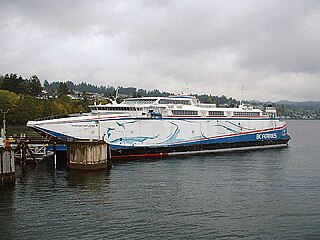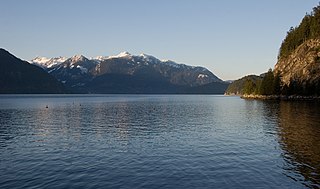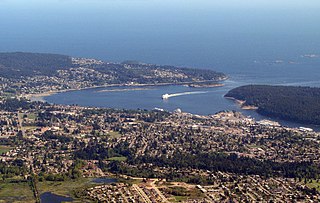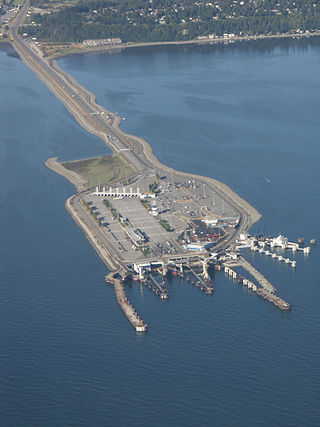
The fast ferry scandal was a political affair in the late 1990s relating to the construction of three fast ferries by the Canadian provincial crown corporation BC Ferries under direction of the Executive Council of British Columbia, headed at the time by Premier Glen Clark of the New Democratic Party.
British Columbia Ferry Services Inc., operating as BC Ferries (BCF), is a former provincial Crown corporation, now operating as an independently managed, publicly owned Canadian company. BC Ferries provides all major passenger and vehicle ferry services for coastal and island communities in the Canadian province of British Columbia. Set up in 1960 to provide a similar service to that provided by the Black Ball Line and the Canadian Pacific Railway, which were affected by job action at the time, BC Ferries has become the largest passenger ferry line in North America, operating a fleet of 41 vessels with a total passenger and crew capacity of over 27,000, serving 47 locations on the B.C. coast.

Nanaimo is a city of about 100,000 on the east coast of Vancouver Island, in British Columbia, Canada. "The Harbour City" was previously known as the "Hub City", which was attributed to its original layout design with streets radiating from the shoreline like the spokes of a wagon wheel, and to its relatively central location on Vancouver Island. Nanaimo is the headquarters of the Regional District of Nanaimo.

Highway 19 is the main north–south thoroughfare on Vancouver Island from Nanaimo to Port Hardy. It forms part of the Island Highway along with Highway 1 and Highway 19A. A highway has existed on the Island since about 1912. Originally gravel and rough, the highway was an essential link together with the Esquimalt & Nanaimo Railway. The paved highway first opened in 1953, replacing a stretch of Highway 1 between Nanaimo and Campbell River, finally being extended to the northern tip of the island in the late 1970s. The total length of the highway is 403 kilometres (250 mi).

The C-class ferries are a class of five double-ended roll-on/roll-off ferries operated by BC Ferries in the Strait of Georgia in British Columbia, constructed between 1976 and 1981. When the vessels were first built, they were the largest ships of their kind in the world. The C-class ferries are 139.29 m (457.0 ft) long, with a car capacity of 316, and a crew and passenger capacity of 1494 persons. Each vessel's two MaK 12M551AK engines produce 11,860 HP, which provides a maximum service speed of 20.5 knots.

Coastal-class ferries, also known as the "Super-C class" are three ferries owned and operated by BC Ferries of British Columbia, Canada and were built at the Flensburger Schiffbau-Gesellschaft shipyard in Flensburg, Germany. They are the second-largest ships in the BC Ferries fleet, surpassed only by the two larger, single-ended Spirit-class ferries. At the time of their building, the three ships were the largest double-ended ferries in the world, however the record has since been surpassed.

The PacifiCat class of fast ferries was operated from June 1999 to March 2000 by BC Ferries in British Columbia, Canada. Three PacifiCat catamarans - Explorer, Discovery, and Voyager - were built between 1996 and 2000 as part of a major public project to improve ferry service between the Lower Mainland and Vancouver Island. The first two catamarans were briefly used for revenue service between Horseshoe Bay in West Vancouver and Departure Bay in Nanaimo from 1999 to March 2000. The third catamaran, PacifiCat Voyager, was completed in early 2000 but had yet to enter revenue service by the time the project was cancelled.

MV Queen of Alberni is a C-class ferry that operates between Tsawwassen and Duke Point in British Columbia as part of the BC Ferries fleet.

Howe Sound is a roughly triangular sound, that joins a network of fjords situated immediately northwest of Vancouver, British Columbia, Canada. It was designated as a UNESCO Biosphere Reserve in 2021.

Departure Bay is a bay in central Nanaimo, British Columbia, on the east coast of Vancouver Island. The surrounding neighbourhood is also referred to as "Departure Bay" —once a settlement of its own, it was amalgamated into the City of Nanaimo in the 1970s.

The Puget Sound Navigation Company (PSNC) was founded by Charles E. Peabody in 1898. Today the company operates an international passenger and vehicle ferry service between Port Angeles, Washington, United States and Victoria, British Columbia, Canada on the MV Coho, through its operating company, Black Ball Ferry Line.

Tsawwassen is a ferry terminal and a major transportation facility in Delta, British Columbia, part of the BC Ferries system and Highway 17. Positioned less than 500 metres (1,600 ft) from the 49th parallel along the Canada–United States border, it is located at the southwestern end of a 2-kilometre (1 mi) causeway that juts out into the Strait of Georgia off the mainland at the community of Tsawwassen. With an approximate size of 23 hectares, it is the largest ferry terminal in North America.

Swartz Bay is a 22.7 ha (56.1-acre) ferry terminal and a major transportation facility at Swartz Bay in North Saanich, British Columbia. It is located 32 km (20 mi) north of Victoria on Vancouver Island. The terminal is part of the BC Ferries system, as well as part of Highway 17.

Horseshoe Bay is a major ferry terminal owned and operated by BC Ferries in British Columbia, Canada. Located in the community of Horseshoe Bay, a neighbourhood of West Vancouver, the terminal provides a vehicle ferry link from the Lower Mainland to Vancouver Island, the Sunshine Coast, and to Bowen Island, a small island in the southern part of Howe Sound.

Nanaimo Harbour, also known as the Port of Nanaimo, is a natural harbour on the east coast of Vancouver Island in the Canadian province of British Columbia. The city of Nanaimo runs along the west side of the harbour. Three islands, Newcastle, Protection, and Gabriola, along with Duke Point, form the eastern edge. The Port of Nanaimo includes the Inner Harbour, Nanaimo River estuary, Departure Bay, the waters on the east side of Newcastle and Protection Islands, and Northumberland Channel. The port is under the management of the Nanaimo Port Authority.

Duke Point is a major ferry terminal owned and operated by BC Ferries that provides ferry service across the Strait of Georgia to Tsawwassen. The ferry terminal is located at Duke Point in Nanaimo and is the only major terminal in the BC Ferries system without a public transit connection.

Bear Cove is a northern Vancouver Island ferry port in British Columbia, Canada. The location on the Queen Charlotte Strait, near the district municipality of Port Hardy in the Regional District of Mount Waddington, provides connections to British Columbia's Central and Northern coasts. The tidal range of the Queen Charlotte Strait is normally between 2 and 6 metres (7–20 ft). The ferry terminal is the northern terminus of Highway 19.

Westview is a ferry terminal in Powell River, British Columbia, Canada. It is located on Malaspina Strait, part of the Strait of Georgia, on the northern Sunshine Coast and provides connections to Texada Island and Vancouver Island. The ferry port is connected to Highway 101 via a short access road.

Langdale is a ferry terminal owned and operated by BC Ferries, which provides ferry services from the Sunshine Coast to the Lower Mainland, Gambier Island, and Keats Island in the Canadian province of British Columbia.

Nanaimo Harbour, highly associated with and commonly referred to as the "Gabriola Island Ferry", is a ferry terminal owned and operated by BC Ferries in British Columbia that goes from downtown Nanaimo across the Northumberland Channel to Descanso Bay on Gabriola Island. The route is serviced by two ferries, the MV Island Gwawis and the MV Island Kwigwis, which can hold up to 47 cars and 450 passengers with a total travel time of about 20 to 25 minutes.



















